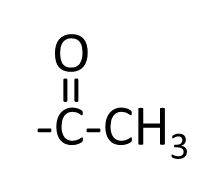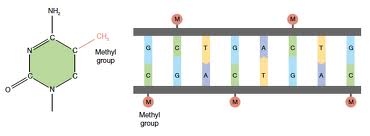Epigenetics
Our genome is established when fertilization takes place, and the code remains unchanged throughout our life, except for mutations that may occur in individual cells. Nevertheless, the previous page outlined many internal mechanisms that operate to control the expression of specific genes. In addition, we now know that many external factors (epigenetics ) can affect the timing of the gene expression, the degree of expression, and the eventual phenotype that is expressed. These external factors can produce small modifications to DNA, such as addition of metal ions, addition or removal of acetyl groups or methyl groups to DNA or to the histones that control the wrapping and packing of DNA. Attachment of methyl groups appears to reduce transcription or even shut it off; attachment of acetyl groups to histones turns genes on. These biological changes to the genome is known as 'epigenetic factors', i.e., changes occurring above the level of the genome.
) can affect the timing of the gene expression, the degree of expression, and the eventual phenotype that is expressed. These external factors can produce small modifications to DNA, such as addition of metal ions, addition or removal of acetyl groups or methyl groups to DNA or to the histones that control the wrapping and packing of DNA. Attachment of methyl groups appears to reduce transcription or even shut it off; attachment of acetyl groups to histones turns genes on. These biological changes to the genome is known as 'epigenetic factors', i.e., changes occurring above the level of the genome.
The methyl group
![]()
The acetyl group

Modification of DNA by the methyl group:

In essence, the DNA in our cells provide the code for making functional proteins, and the epigenetic factors act as switches which turn genes off and on. Epigenetic factors are likely to play many important roles, such as:
- Turning genes off and on as differentiation proceeds in a growing embryo. As a result, some cells in the pancreas become specialized to produce digestive enzymes, while others synthesis the hormone insulin.
- Epigenetic factors in utero may have a lasting influence on phenotype years later. If a pregnant agouti mouse is fed a folate enriched diet that provides methyl groups, it's offspring will have dark coats and be lean and healthy, because a particular gene is turned on; if the diet is poor in methyl groups, the offspring will be obese and light coats. In the winter of 1944-45 the German army set up a blockade to prevent food and fuel from reaching the western part of Belgium, reducing food consumption to exceptionally low levels for the winter. Fifty years later researchers compared the children who were conceived to starved mothers during that period to mothers who were already in their second or third trimester when the blockade began. They found that the offspring of the starved mothers weighed 14 pounds more on average, had waist circumferences that were 1.5 inches greater, and were more likely to have developed coronary heart disease.
- Certain genes are know to predispose to certain types of cancer, such as breast and colon cancer. If is tantalizing to think about the possibility of turning such genes off epigenetically in order to reduce the risk of developing these cancers.
Epigenetics and the Influence of Our Genes
This is an 18:40 min video from TEDxOU by Courtney Griffin that provides an excellent explanation of the interaction among:
- nature
- nurture
- epigenetics
In summary, all of our traits and characteristics (our phenotype) are the result of an interaction between our genome (all of the genes we inherit) and environmental factors. Some environmental factors (including our diet, our behaviors, and a myriad of environmental exposures) influence our phenotype through non-genetic mechanisms. For example, one might have a number of genes that predispose an individual to being lean; however, such an individual might still become overweight or obese despite their "lean genes" as a result of chronically overeating. Yet other epigenetic factors from the environment can modify the genome in subtle ways without actually changing the code.
For more information on epigenetics explore the following web site: http://learn.genetics.utah.edu/content/epigenetics/
Did you know?
Pink hydrangeas can be made to turn blue by adding aluminum sulfate to the soil.



